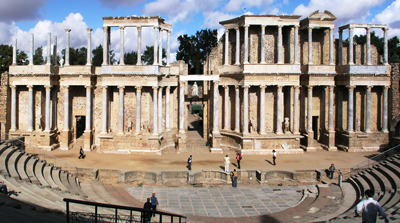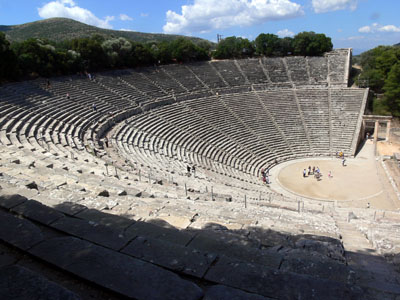The World of the Theater
 The fact that nearly every Greek and Roman town contained its own open-air theater attests to the widespread popularity of live entertainment, a tradition that probably originated from annual festivals in honor of the god Dionysus. The orchestra, a semi-circular space, was constructed at the base of a small hill, while the slope of the hill itself produced a natural viewing area, known as the theatron (literally, “watching place”). Eventually, a freestanding backdrop, or skene (from which the English word “scene” derives), was built behind the orchestra, and tiered seating, first of wood and later of inlaid stone, was added to the theatron. Other elements of theater performance included cranes, trap doors, the proskenion (a raised platform that separated the audience from the actors), and wheeled stage sets and wagons to transport characters on stage.
The fact that nearly every Greek and Roman town contained its own open-air theater attests to the widespread popularity of live entertainment, a tradition that probably originated from annual festivals in honor of the god Dionysus. The orchestra, a semi-circular space, was constructed at the base of a small hill, while the slope of the hill itself produced a natural viewing area, known as the theatron (literally, “watching place”). Eventually, a freestanding backdrop, or skene (from which the English word “scene” derives), was built behind the orchestra, and tiered seating, first of wood and later of inlaid stone, was added to the theatron. Other elements of theater performance included cranes, trap doors, the proskenion (a raised platform that separated the audience from the actors), and wheeled stage sets and wagons to transport characters on stage.
 Plays were performed by a combination of individual actors and a chorus, who sang to musical accompaniment and also danced. All the actors wore masks, allowing them to play more than one role in a performance, and the exaggerated features of each mask facilitated the audience’s recognition of the numerous characters, especially from a distance. Many such details of theatrical performance appear on Greek vases and Roman frescoes and mosaics, which not only provide information about stage design, costumes and props, but also attest to the ubiquity of theatrical motifs in all venues of ancient life.
Plays were performed by a combination of individual actors and a chorus, who sang to musical accompaniment and also danced. All the actors wore masks, allowing them to play more than one role in a performance, and the exaggerated features of each mask facilitated the audience’s recognition of the numerous characters, especially from a distance. Many such details of theatrical performance appear on Greek vases and Roman frescoes and mosaics, which not only provide information about stage design, costumes and props, but also attest to the ubiquity of theatrical motifs in all venues of ancient life.
Image credits: Theater at Mérida, Spain, begun late 1st century BCE. Photograph courtesy of Wikimedia Commons.
Theater at Epidaurus, Greece, 4th century BCE. Photograph courtesy of Wikimedia Commons.

 Earlier
Earlier









